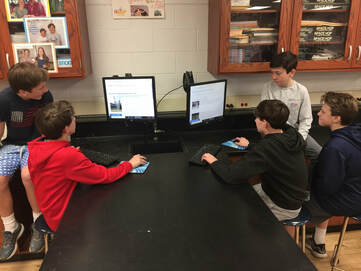Systemic Sustainability: 1.1 Curriculum and Instruction
SPMS Science Environmental Literacy Standards
 Student members of the 2018-19 green school committee work on the application.
Student members of the 2018-19 green school committee work on the application.
In AACPS, environmental literacy is embedded in science curriculum throughout each middle school grade level. While existing science curriculum includes some environmental issues embedded within, it does not involve an action plan or stewardship piece like that of the Environmental Literacy Objectives. Defined Outcomes are consistent across all AACPS schools. However, the degree to which the outcomes are accomplished and the manner in which they are delivered varies from school to school and classroom to classroom. This is where SPMS teachers shine! From planning to delivery, SPMS teachers bring the county and state mandated curriculum requirements to life for their students.
Grade 6 : How Do We Use the Chesapeake Bay Sustainably? Through the ecology of Chesapeake Bay species and restoration projects, students examine the human interaction with the environment including policy, economics, and historical significance in addition to stormwater runoff, the biology of living things, restoration, and pollution. Students participate in a field experience and action projects depending on the project for their school. All projects use water quality and environmental issues affecting living things to investigate the Chesapeake Bay.
Grade 7: Students explore chemical reactions and the transfer of energy through the lens of an environmental literacy project. Students use concepts of physics, chemistry, biology and ecology to analyze and interpret both positive and negative impacts of human activities on Earth's natural systems and resources.
Grade 8: How Are Humans Affecting Our Global Environment? Students investigate the causes and effects of environmental change. Students work in cooperative groups to research one of the ways that humans impact the natural change process. Students learn about global issues such as climate change and invasive species. Also, students examine ways to make cities of the future more sustainable and design their own "Eco-City" using practices developed and implemented in model cities.
Grade 6 : How Do We Use the Chesapeake Bay Sustainably? Through the ecology of Chesapeake Bay species and restoration projects, students examine the human interaction with the environment including policy, economics, and historical significance in addition to stormwater runoff, the biology of living things, restoration, and pollution. Students participate in a field experience and action projects depending on the project for their school. All projects use water quality and environmental issues affecting living things to investigate the Chesapeake Bay.
Grade 7: Students explore chemical reactions and the transfer of energy through the lens of an environmental literacy project. Students use concepts of physics, chemistry, biology and ecology to analyze and interpret both positive and negative impacts of human activities on Earth's natural systems and resources.
Grade 8: How Are Humans Affecting Our Global Environment? Students investigate the causes and effects of environmental change. Students work in cooperative groups to research one of the ways that humans impact the natural change process. Students learn about global issues such as climate change and invasive species. Also, students examine ways to make cities of the future more sustainable and design their own "Eco-City" using practices developed and implemented in model cities.
